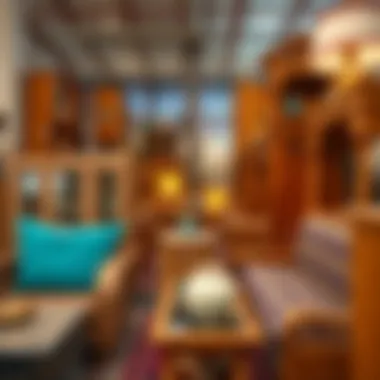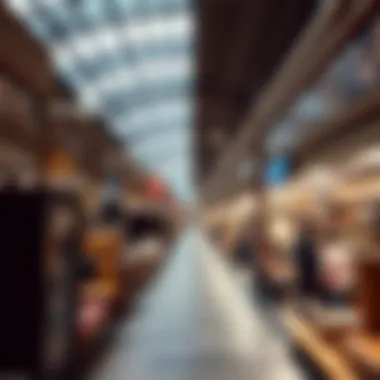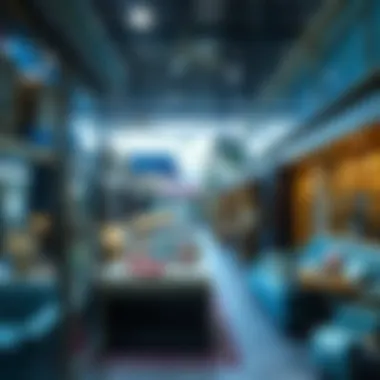Insight into the Karama Furniture Market in Dubai


Intro
The Karama furniture market in Dubai offers an intense blend of culture and modernity, drawing in both locals and tourists alike. As anyone who's strolled through its vibrant lanes can attest, the market boasts an impressive array of furnishings, from classic wooden pieces handcrafted by skilled artisans to sleek, contemporary designs that speak to modern aesthetics. In an era where tastes are shifting, understanding this market is not just about finding the right sofa or dining table; it’s about grasping the intricate dance between customer preferences, pricing strategies, and vendor dynamics.
This analysis aims to unpack the layers of this bustling marketplace, from what catches buyers' eyes to how economic conditions shape purchasing decisions. Moreover, a spotlight will be thrown on emerging trends and challenges vendors and consumers face, creating a comprehensive picture that extends beyond mere transactions. As we navigate through these themes, it’s essential to appreciate the larger economic implications, especially given that Dubai's real estate sector is increasingly buoyed by interior design choices that reflect lifestyle aspirations.
Understanding the Karama furniture market requires not only a keen eye for detail but also an appreciation for its role in the broader context of Dubai’s economic landscape. Let’s dive deeper into the market insights that shape consumer behavior and land the best furniture deals, shall we?
Preface to the Karama Furniture Market
The Karama furniture market is not just another shopping district in Dubai; it's a lively tapestry woven from various threads of culture, artistry, and commerce. For investors and homebuyers alike, understanding this market is fundamental for grasping the nuances of Dubai's dynamic real estate landscape. The intricate dance of traditional and modern furniture here invites keen observers to appreciate more than just aesthetic value; it transcends to reflect local heritage and evolving consumer preferences.
One of the primary elements of the Karama market is its diversity. You will stumble upon local artisans creating stunning pieces that echo the past, sitting right beside sleek, contemporary designs from renowned international brands. This juxtaposition caters to various tastes, making it a treasure trove for home furnishing.
A more than cursory glance reveals the myriad benefits that the Karama market offers. From affordable everyday items to exquisite custom-made works, there’s something to satisfy every budget and necessity. Moreover, it's essential to note how the local design influences ebb and flow, moving with the pulse of society's changing ideals, which can lead to highly sought-after trends.
As potential investors or agents targeting high-value clientele, being well-versed in such local markets can significantly enhance their strategies. This knowledge is also pertinent to developers looking to position their projects successfully within the existing retail landscape. When the on-ground dynamics are well understood, it positions stakeholders to make informed decisions, be it in procurement, investment, or marketing strategies.
"In a city where tradition meets innovation, the Karama furniture market serves as a bellwether for consumer behavior in the home furnishing domain."
The insights gleaned from this section will serve as a launchpad for subsequent discussions regarding historical contexts, the types of furniture available, and market dynamics. When examining the components of this vibrant marketplace, it becomes evident that the Karama furniture market holds significant relevance not only for its local inhabitants but also for those connected to the broader economic implications within Dubai's burgeoning real estate sector. Its ability to adapt and change, reflecting the times, makes it a focal point worthy of meticulous analysis.
Historical Context of Furniture in Karama
Understanding the historical backdrop of the Karama furniture market is akin to peeling back the layers of a well-crafted wooden table; each layer reveals stories and significance woven through time. The history offers insights into how cultural influences, social change, and economic developments shape the design and availability of furniture in this vibrant community.
This exploration is not merely of nostalgic interest; instead, it lays the groundwork for appreciating contemporary consumer preferences and market trends. By recognizing the past, investors, homebuyers, and developers can make informed decisions about what resonates with today’s buyers.
Early Origins
The roots of the furniture market in Karama can be traced back to the pre-oil era, when the area was primarily a hub of trade. In those days, local artisans produced handcrafted items, often using materials such as palm fronds, wood, and clay. The furniture crafted during this time reflected a traditional Arabic aesthetic, marked by intricate carvings and motifs.
"Early furniture in Karama wasn't just functional; it was a statement of cultural identity."
As the market began to evolve, these artisans relied heavily on local resources. The design philosophy was simple — functional pieces that served everyday needs while incorporating elements of beauty. Items like low seating cushions or majlis furniture were common in homes, emphasizing hospitality, which is a central tenet of Arab culture. This cultural context instilled a sense of pride in craftsmanship that resonates even in today's pieces.
Transformation Over the Decades
The significant changes began in the 1970s with the discovery of oil, which catalyzed rapid urbanization in Dubai and, consequently, in Karama. The once simplistic and rustic offerings expanded as expos and global trade entered the scene. Retail showrooms sprang up, and imports from countries like Italy, India, and Turkey enriched the variety in styles.
As people began to travel and experience various cultures, the demand for modern furniture that reflected these global influences grew. Trends shifted toward minimalistic designs and multifunctional pieces due to smaller living spaces, reflecting a new way of life. The aesthetic of traditional Arabic furniture began to blend with contemporary styles, cultivating a unique market that serves residents’ diverse tastes.
Over the years, the competition heated up, not just among local artisans but also with the entry of international brands. These changes democratized furniture availability, allowing consumers access to a wide range of choices at varying price points. As a result, the once homogenous landscape started displaying a vibrant mix of traditional and modern influences, catering to a younger audience that values both heritage and innovation.
Ultimately, the historical context of furniture in Karama not only tells the story of evolving designs but also serves as a barometer for social changes affecting the community. Investors and developers can glean insights from this rich history that inform current and future market strategies.
Type of Furniture in the Market
Understanding the type of furniture available in the Karama furniture market is crucial. This section focuses on various furniture styles that attract buyers, ensuring they find pieces that resonate with their taste and suit their needs. From traditional Arabic craftsmanship to modern, sleek designs, the array of options reflects the rich cultural tapestry of Dubai while catering to contemporary demands. Additionally, exploring custom-made options allows for personalization, a key trend that continues to gain traction among consumers seeking uniqueness in their home décor.
Traditional Arabic Furniture
Traditional Arabic furniture embodies a rich history and cultural significance that mirrors the lifestyle and values of the region. It often features intricate carvings, vibrant fabrics, and bold geometrical patterns. This style presents a sense of warmth and hospitality, qualities that are highly valued in Arab culture. Pieces such as elegant diwan seating, wooden majlis tables, and decorative mashrabiya screens lend authenticity to homes and invite gatherings.
The careful selection for these pieces ensures that buyers appreciate the artistry while also celebrating heritage. Customers often favor wooden furniture made from local materials, like cedar and teak, which not only showcase craftsmanship but also withstand the test of time. When adding traditional Arabic furniture to a home, buyers are not just furnishing a space; they are telling a story and honoring a legacy.
Modern and Contemporary Styles
In contrast to its traditional counterpart, modern and contemporary furniture represents a departure from the norm, catering to a generation that seeks minimalist aesthetics and functionalities. Sleek lines and innovative designs characterize this segment, focusing on practicality without compromising style. Here, furniture pieces are often made from materials like stainless steel, glass, and high-density foam to ensure durability and ease of maintenance.


Among the popular items are modular sofas and multifunctional tables designed for compact living spaces. The appeal of modern furniture lies in its adaptability to various interior designs, allowing buyers to mix and match pieces that reflect their personal tastes. This flexibility opens the door to a world of creativity in home decor, helping consumers curate a space that feels uniquely theirs.
Custom-Made Options
Custom-made furniture options have increasingly become a favored choice for many consumers in the Karama market. This trend allows buyers to collaborate with local artisans and designers to create unique pieces that align directly with their vision and space requirements. Customers can select materials, colors, and designs that best fit their aesthetic and functional needs.
Opting for custom-made furniture also supports local craftsmanship and encourages a sense of community. While many mass-produced items lack individuality and character, custom pieces resonate more deeply with their owners, often becoming cherished heirlooms.
In today's market, where personalization is key, the ability to create bespoke furniture not only enhances the customer experience but also fosters loyalty to local craftsmen. The relationship built during this process can lead to mutual benefits, establishing a strong network between artisans and discerning buyers.
"The charm of the Karama furniture market lies in its diversity—where tradition meets modernity, and creativity knows no bounds."
Through this exploration of furniture types, consumers are better equipped to navigate the Karama market, recognizing what resonates with their lifestyle, budget, and home aesthetic.
Key Players and Suppliers
The Karama furniture market is marked by a diverse ecosystem of key players and suppliers who contribute significantly to its vibrancy. Within this dynamic environment, local artisans and craftsmen, major retail chains, and international brands occupy unique niches, offering various styles and catering to different consumer needs. Understanding the role of these key players is vital for investors and stakeholders keen on navigating this market effectively.
Local Artisans and Craftsmen
In Karama, the craftsmanship of local artisans is commendable. These skilled individuals often imbue traditional designs with a modern twist, preserving the rich cultural heritage of the region while appealing to contemporary tastes. Their products can often be spotted at local markets, where hand-carved wooden furniture or intricately designed textiles tell stories of craftsmanship honed through generations.
Local artisans are the heartbeat of Karama's furniture scene, infusing each piece with a blend of tradition and individual flair.
When considering purchases, consumers have the opportunity to support local businesses, which not only fosters community but also ensures that the pieces they buy carry a level of individuality seldom achieved in mass-produced items. This local flavor often translates into higher quality materials, seen in items like solid wood tables or ornate chairs that stand the test of time.
Major Retail Chains
While the artisanal offerings reflect rich history and individual creativity, major retail chains provide variety, accessibility, and often competitive pricing. Stores like IKEA and HOMES R US have established a robust presence in Karama, making it easier for consumers to find trendy, ready-to-assemble furniture. Their wide range of products can appeal to both cost-conscious buyers and those seeking stylish options without breaking the bank.
Benefits of Major Retail Chains:
- Variety of Styles: From minimalist designs to eclectic pieces, major chains cover a broad spectrum of aesthetics.
- Affordable Pricing: Competitive prices allow for budget-friendly choices for homebuyers and renters alike.
- Convenience: Locations are accessible, and the availability of online shopping adds to consumer convenience.
However, mass production often compromises the uniqueness of items, which is something that discerning buyers remain wary of.
International Brands
In recent years, the influx of international brands into the Karama scene has transformed the landscape further. Iconic names like Ashley Furniture and Muji bring with them global standards of design and quality. Their presence elevates the local market, offering consumers access to the latest trends that resonate globally.
These brands typically stand out for their adherence to sustainable practices and advanced manufacturing techniques. In particular, their commitment to eco-friendly materials addresses the growing consumer demand for sustainable choices.
The international brands act as potent market catalysts, pushing local providers to innovate and compete.
Considerations for International Brands:
- Quality Assurance: Global brands often come with guarantees of quality, which can greatly influence purchasing decisions.
- Brand Reputation: The pedigree of the brand often reassures consumers, making them willing to invest more in recognizable names.
- Innovative Designs: Cutting-edge designs and trends become accessible, influencing local tastes and preferences.
Consumer Trends and Preferences
Understanding consumer trends and preferences is crucial for anyone involved in the Karama furniture market. This section sheds light on how the evolving inclinations of customers influence the market dynamics. When we talk about furniture, it’s not just about aesthetics or functionality, it’s about understanding what makes potential buyers tick. The decisions made by consumers directly affect various aspects of this market, from pricing strategies and product offerings to the overall health of the local economy.
Shifts in Buying Behavior
In recent years, there has been a notable shift in buying behavior among consumers in the Karama furniture market. Historically, customers would frequent physical stores, driven by their desire to experience the tactile elements of furniture before purchasing. However, this pattern is changing rapidly.
With the rise of technology and accessibility to information online, customers are turning to digital sources more frequently. They research products, read reviews, and even make purchases without setting foot in a store. Factors such as convenience, time-saving, and improved online shopping experiences are some of the driving forces behind this transition.
To illustrate, many consumers now prefer to browse options on websites like IKEA or local online retailers, comparing prices and features with just a few clicks. This shift suggests that businesses in Karama will need to adapt to ensure they create seamless omni-channel experiences that serve both traditional shoppers and those leaning towards e-commerce.


Sustainability and Eco-Friendly Choices
As consumers grow increasingly aware of environmental issues, a significant trend in the Karama furniture market underscores the importance of sustainable practices. Customers are becoming more conscious of the ecological footprint of their purchases. This awareness shapes their preferences for products made from eco-friendly materials and those designed with sustainability in mind.
Buyers often look for furniture that is not only aesthetically pleasing or functional but also responsibly sourced. Many are willing to invest in items from artisans who practice ethical craftsmanship. Companies that offer detailed information about sourcing, production methods, and certifications for eco-friendly materials can gain a competitive edge.
- Furniture made from reclaimed wood or recycled materials is becoming a popular choice.
- Consumers are also increasingly interested in brands that commit to reducing carbon footprints through sustainable manufacturing processes.
“The modern buyer not only seeks out style and comfort but also brands that resonate with their values, especially in regards to sustainability.”
The implications for sellers are significant. Adapting to these evolving consumer values not only paves the way for an enhanced customer base but can also drive loyal patrons who advocate for sustainable choices in their communities. Hence, those involved in the Karama furniture market must recognize and respond to this growing demand for eco-friendly options to remain relevant.
Pricing Dynamics in the Furniture Market
Understanding the pricing dynamics in the furniture market is crucial for a multitude of stakeholders involved in this vibrant sector. From investors and homebuyers to agents and developers, these nuances determine not only the profitability but also the accessibility of furniture for consumers. The Karama furniture market, in particular, presents a unique blend of both traditional and modern influences, which directly impacts pricing strategies. This section will shed light on the elements that drive prices, the factors affecting consumer purchasing decisions, and how these interlink with the overall economic fabric of Dubai.
Factors Influencing Prices
The prices in the Karama furniture market can be influenced by several distinct factors that vary widely:
- Material Quality: The type of materials used in the construction of furniture, such as solid wood versus particle board, plays a significant role in price determination. High-quality materials may command a premium, whereas more affordable options might cater to budget-conscious consumers.
- Design Complexity: Intricate designs and craftsmanship often justify higher price points. Custom-made items or traditional Arabic furniture, which may showcase elaborate work, tend to be more expensive compared to simpler contemporary designs.
- Market Demand: Demand fluctuations can shift prices like the tide. For instance, during festive seasons or after major real estate developments, the demand for furniture can surge, pushing prices up.
- Operational Costs: Costs related to manufacturing, logistics, and showroom maintenance can significantly impact retail prices. Vendors with efficient operational practices may offer competitive pricing, while others might pass increased costs onto consumers.
- Exchange Rates and Import Duties: For international brands or imported materials, currency fluctuations and government tariffs can lead to unpredictable pricing. This can deeply affect the affordability of certain product lines in the Karama market.
Average Price Ranges for Various Items
When it comes to understanding what you might expect to pay in the Karama furniture market, here’s a breakdown of typical price ranges for various types of furniture:
- Sofas: Prices can range broadly between AED 1,500 to AED 7,000 depending on the brand, fabric quality, and design intricacies.
- Dining Tables: Expect to pay anywhere from AED 800 to AED 5,000, again depending on materials and artistic craftsmanship.
- Bedroom Sets: These usually fall within the AED 2,000 to AED 10,000 range. Factors such as included pieces (like dressers and nightstands) heavily influence the price.
- Accent Chairs: Simple designs start around AED 500, while designer pieces can escalate to AED 3,000 or more.
- Custom-Made Furniture: If you’re leaning towards custom options, prices can start at AED 2,500 and soar to AED 10,000 or beyond, based on the complexity and uniqueness of the design.
As you evaluate these prices, it’s vital to bear in mind both your budget and the long-term value that furniture can provide. Investing in higher-quality items can often yield better durability and satisfaction over time.
"In the realm of furniture, you often get what you pay for—balancing quality and cost is key to ensuring your investment stands the test of time."
Overall, grasping these pricing dynamics not only equips consumers with better buying strategies but also aids vendors in setting competitive yet profitable prices.
Challenges Facing the Karama Furniture Market
In today’s fast-evolving market landscape, the Karama furniture sector encounters a series of challenges that are not just a hiccup but could influence long-term sustainability and growth. Understanding these hurdles is essential for stakeholders, particularly investors, homebuyers, and developers, who are keen on navigating this dynamic environment. The focus here will shed light on three principal challenges: competition from e-commerce, quality control issues, and regulatory hurdles.
Competition from E-commerce
The rise of e-commerce has transformed the way consumers shop for furniture. Websites like IKEA and Amazon offer enticing options, often at competitive prices, drawing potential buyers away from traditional brick-and-mortar shops. Shoppers now gravitate towards the convenience of purchasing furniture online, often with the appeal of direct shipping and easy returns.
- Wide Range of Options: E-commerce giants showcase hundreds of styles and variations, much more than a local store can display. This vast selection can sway consumers towards online platforms.
- Price Sensitivity: Online retailers frequently run sales and promotions, making it challenging for local businesses to match these aggressive pricing strategies without incurring losses.
As buyers become accustomed to the ease of online shopping, it leaves local retailers scrambling to keep up, often forcing them to rethink marketing strategies and customer engagement initiatives.
"In the era of online shopping, convenience is king. If local businesses don’t adapt quickly, they risk being crowned the court jester in the furniture market." - Anonymous
Quality Control Issues
Quality assurance is pivotal for any market, and in Karama, the stakes can be particularly high. From sourcing materials to final production, discrepancies can result in customer dissatisfaction and damage to a brand's reputation. Local artisans face difficulties ensuring consistent quality in their offerings. There are a few elements to consider here:
- Sourcing Materials: Many artisans rely on a mix of local and imported materials. The variation in quality from suppliers can greatly influence the final product.
- Skilled Workforce: The availability of skilled craftsmen can vary, which directly impacts quality. An untrained hand can lead to subpar construction or finishing.
- Consumer Expectations: A well-informed consumer base holds higher standards for quality, expecting not only well-crafted pieces but also durability and aesthetics.
Addressing these quality concerns is essential not just for maintaining customer trust, but also for strengthening the entire Karama furniture market.
Regulatory Challenges
Regulation presents another layer of complexity in the Karama furniture market. Local laws governing production, import/export tariffs, and safety standards continuously shift, which can create a risky environment for businesses. Key regulatory challenges include:


- Compliance Costs: Meeting health and safety regulations can be financially burdensome, especially for small to medium-sized businesses who might lack the resources to adapt swiftly.
- Import Restrictions: Fluctuating tariffs and restrictions on imported materials can spark unpredictability in raw material costs, affecting pricing and profit margins.
- Inspections and Licenses: Managing the bureaucratic demands of permits and inspections can be time-consuming, diverting attention from other vital aspects of business management.
As these regulatory challenges evolve, businesses must remain vigilant. Adaptability becomes a crucial strategy, as legislation can change rapidly, entailing the need for flexibility in operations.
Impact of the Karama Furniture Market on Local Economy
The furniture market in Karama isn’t just a treasure trove for shoppers; it plays a pivotal role in shaping the local economy. From sustaining employment to generating tax revenue, the repercussions of this vibrant market echo through various facets of the community. By grasping the extent of its influence, one can truly appreciate why this market is a cornerstone for not only home decor enthusiasts but for economic growth in Dubai.
Employment Opportunities
Karama’s furniture market is a lifeline for many families in the area. Numerous small businesses, artisan shops, and larger retail chains are scattered throughout its bustling streets, collectively employing a considerable number of individuals.
- Job Creation: With thousands of furniture-related businesses operating, from manufacturers to retailers, the ability to create jobs is significant. Employment options range from logistics to sales, design, and crafting. These jobs not only provide a paycheck but often come with opportunities for skill development and advancement.
- Cultural Skills Preservation: Certain artisans still use traditional methods of furniture-making, passing skills from one generation to the next. This not only keeps cultural heritage alive but provides a unique employment niche, preserving time-honored techniques.
- Economic Multiplier Effect: Each job in the furniture market often leads to more. Employees spend their earnings in local grocery stores, schools, and service industries, thus stimulating further economic activity in the region. This rings true like a well-tuned bell throughout Karama and beyond.
These elements weave together to create a robust employment network that significantly bolsters the local economy.
Tax Contributions to the Local Government
When you stroll through Karama's furniture market, remember that each purchase and every business operation feeds into a larger economic framework. These businesses contribute not only to their own survival but to the greater financial ecosystem of Dubai.
- Sales Tax Revenue: Furniture sales contribute to substantial sales tax revenue, which local governments depend on to fund essential public services. This revenue supports schools, healthcare, and infrastructure improvements, thus enhancing the quality of life for all residents.
- Business Licensing and Regulatory Fees: Establishing a furniture store means adhering to various regulatory frameworks and fees. These business licenses and compliance measures also generate revenue for local governance, ensuring that public services remain funded and community needs are met.
- Community Development Projects: Ultimately, the funds collected through taxation enable the government to invest in community projects—from parks to community centers—that enhance the living environment and encourage further business growth.
"The health of the local economy can often be gauged by the vibrancy of its markets. The Karama furniture market is no exception. It's a critical contributor to both employment and long-term public investment."
Future Trends in the Karama Furniture Market
The Karama furniture market is not just a collection of shops and showrooms; it’s a constantly moving landscape shaped by consumer demands and technological advances. Understanding future trends in this market is vital for everyone from investors to homebuyers looking to make savvy purchasing decisions. This section will delve into the key shifts on the horizon, illustrating their importance for those involved in the market.
Technological Integration in Retail
The rise of technology in retail cannot be overstated. In Karama, furniture businesses are starting to embrace technology at a rapid pace. From augmented reality applications that allow consumers to visualize how a piece of furniture might look in their homes, to sophisticated point-of-sale systems that streamline the buying process, digital tools are redefining the shopping experience.
A notable example of this trend is the increasing integration of e-commerce platforms with physical showrooms. Shoppers can now browse a selection of items online, then visit the store to see, touch, and feel the products before making a purchase. Not only does this enhance the customer experience, but it also allows retailers to maintain a more extensive inventory without requiring a vast physical space. This flexibility can help businesses to react swiftly to changing consumer preferences.
Moreover, social media is becoming an increasingly powerful sales channel. Platforms such as Instagram and Facebook provide a unique opportunity for brands to showcase their offerings and create engaging narratives around them. By utilizing targeted ads and influencer partnerships, retailers can reach potential buyers more effectively than ever before.
"Technology in retail is not just about efficiency; it’s about delivering a more meaningful experience for consumers."
Shifts Toward Remote Shopping
The landscape of shopping has drastically changed, particularly in the wake of the COVID-19 pandemic. Customers are more inclined to pursue remote shopping options, making it critical for furniture retailers to adapt. The convenience offered through online platforms has made it easier for consumers to peruse furniture collections from the comfort of their sofas, which has led to a noticeable increase in online sales.
As remote shopping becomes the norm, furniture retailers in Karama are boosting their online presence and e-commerce capabilities. This includes offering virtual consultations where customers can discuss their needs with experts over video calls. Enhanced customer service not only drives sales but also builds brand loyalty, a crucial factor in ensuring repeat business.
Furthermore, investing in logistics is essential to support remote shopping. Efficient delivery systems and hassle-free return policies are no longer just advantages; they are must-haves. Furniture retailers must prioritize these aspects to stay competitive in this evolving market.
The End: The Significance of the Karama Furniture Market
The Karama furniture market stands as a notable thread in the broader tapestry of Dubai's economic and cultural landscape. Its significance extends beyond mere commerce; it fosters community, tradition, and modernity all at once. The market not only serves as a platform for sales but also acts as a reflection of the consumer's evolving preferences, lifestyle choices, and cultural identity.
One cannot emphasize enough how this market is a melting pot of influences, combining local craftsmanship with global trends. It offers a unique opportunity for buyers to explore an array of styles, from traditional Arabic designs to sleek modern pieces. This diversity speaks volumes about the market's ability to cater to varied tastes, making it an essential stop for both residents and tourists alike.
Key Considerations
- Economic Contributions: The Karama market contributes significantly to the local economy. Through job creations in crafting, retail, and logistics, it generates numerous employment opportunities. Furthermore, the taxes collected from sales bolster the local government’s revenue, allowing for better infrastructure and community services.
- Cultural Significance: Beyond its economic footprint, the market serves as a cultural haven where traditional practices meet contemporary innovations. It protects local artisans' crafts, showcasing their skills while enabling them to thrive in a competitive market. This cultural blend enriches the city's identity, appealing to a wide audience seeking authenticity.
- Adoption of Trends: As consumer preferences shift toward sustainability, many vendors in Karama are adapting to these demands. This responsiveness not only reflects environmental concerns but also positions the market as a forward-thinking hub in Dubai. Facilities that promote eco-friendly options are increasingly gaining traction, demonstrating the market's alignment with global trends.
Final Thoughts
In closing, the Karama furniture market is more than just a place where goods are bought and sold. Its significance is interwoven with the local economy, cultural heritage, and the ever-changing landscape of consumer behavior. Investors, homebuyers, and industry analysts alike should view this market as a dynamic entity worth their attention. Engaging with it not only opens doors to potential financial gain but also allows for a deeper appreciation of the rich cultural fabric of Dubai.
"The essence of the Karama furniture market lies in its ability to adapt and evolve, resonating with a community that values both heritage and innovation."
In summary, the Karama furniture market is a crucial component of Dubai’s vibrant real estate and retail scene, representing a significant model of how local markets can thrive within a global context.
For more insights, consider checking resources like Wikipedia or local articles on Reddit discussing the market's developments.
Stay tuned as trends continue to unfold, shaping the future of this intriguing market.











